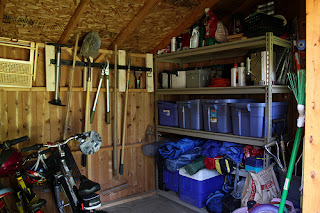Important advices
If you have a wooden floor, ideally the shed should be about 15 cm distant of the ground, to keep it away of moisture. So having a ramp will be necessary to store heavy machines like tractors. Although it seems to be an easy project – and it is, when compared to building the shed itself – it’s important to build a strong structure to ensure it doesn’t break while driving something heavy through it.
The first and most important issue I would like to talk about is the slope. It may be a temptation to build a steeper ramp because it will be shorter and you’ll save space. However you must build something functional and secure. You want to save your tractor easily and without the risk of tip. Such a heavy machine could cause serious injuries in that situation. Another important point is that with a big slope ramp your tractor might scrape the top of it, especially if it has additional devices. It’s also important to ensure that it is large enough to keep a security margin.
Ramps are usually made of metal or wood. If you don’t want to build one, some companies sell them if you can pay for it. It’s possible to acquire removable ramps with the advantage of only using it when necessary.
If you opt for building a wooden, permanent one, choose treated wood, because the ramp will be in constant contact with humidity so treatment will help to prevent it from rot.
A simple and efficient structure is the one showed bellow:
 |
| Shed ramp |
It is composed by 3 main elements: the support structure, the lumber that fixes the ramp to the shed and the ramp coating.
The fixative lumber should have enough length to support the ramp width.
The support structure will distribute the force applied on the ramp. Build a ramp with at least 3 support pieces of wood: two at the extreme sides and one at the middle, all separated by equal distances. By this way will have a proportional distribution of weight. If you only apply them in the sides you will leave the middle with no support and the risk of breaking there will be high. Of course it will depend on the ramp width and in what you want to use it for. A ramp with a narrow width can require only two and a larger one can require more than three. The more support elements you use the more robust your ramp will be but the weight force on the link lumber will increase. So the ideal is to find the equilibrium.
Main steps
1.Prepare the pavement: level the part where the support structure will settle down.
2.Cut the support lumber with the correct size. You’ll have to make two cuts, which will depend on the slope you pretend for your ramp: one to fit in the ground and another to fit in the link board.
3.Screw the link board to the shed entrance beam and fix the support plaques to it. Ensure you leave space for the coating: measure its thickness and leave that value, in order to the ramp be perfectly aligned with the shed floor.
4.Finally coat the structure with several boards or apply plywood to it.
In addiction you can nail rubber wedges in order to get traction. They will help a lot in rainy conditions.
Another solution
There are other structure possibilities. This site offer free shed plans as a sample of their product which include information about how to build a ramp in a different way. All you have to do is to fill the form in the site's bottom with your first name and e-mail adress (the form may also appear in the left side after entering the site). Then an e-mail will be sent to you with downloadable plans.
If you have other building ideas share them leaving a comment below. The blog readers and myself will apreciate that.
Good luck building your ramp!
Other helpful posts:















